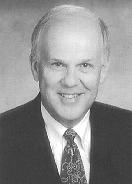William L. George
For his outstanding contributions to the semiconductor industry in the development of advanced semiconductor manufacturing processes, materials, and equipment, the Schools of Engineering are proud to present the Distinguished Engineering Alumnus Award to William L. George.
Corporate Vice President and Director, Die Manufacturing
Motorola Inc.
PhD 1968

On his Purdue experience
I had a National Science Foundation fellowship that allowed me to go anywhere for a doctoral program in materials engineering. M.I.T., Stanford, Carnegie Mellon, and Purdue were tops in the field. My wife's parents had spent time in Lafayette, and we felt it was a nice place to be, so we decided to go there.
Purdue was about twice as big as the University of Oklahoma, where I had gotten my bachelor's degree, and it was more of an engineering and science kind of school. The focus was on education. The nice thing was that the School of Materials Engineering was a small community, and so MSE students had the advantages of being at a large university and in a small group. We got to know the faculty and each other pretty well.
I wound up in a program that was part materials engineering, part physics, and part electrical engineering. Probably the toughest single time I had at Purdue was on a take-home exam in a solid-state physics course-I hadn't had much background in that area. The class divided up into teams of two and worked for three weeks on the test, and I made a 61 on it.
But just getting through the doctoral program and doing the experimental work on my thesis was a challenge. I learned a great deal from professors Richard Grace, Peter Winchell, and Jerry Liedl. Professors Grace and Liedl, I remember, had a lot of common sense and could guide us in professional, personal, and academic matters. Overall, Purdue was a good place for learning.
On career highlights
Two assignments I've had during my career stand out in terms of their long-term effects on the semiconductor industry and industrial policy. From 1987 to 1991 I was the first director of the Motorola-Toshiba Alliance, a joint venture designed to provide both companies access to market-leadership products to serve customers worldwide. The joint manufacturing company, Tohoku Semiconductor Corporation, built and operated two factories during my tenure, and two factories have been started since. Continuing enhancement of the partnership provides mutual benefits utilizing the complementary strengths of each company. In February 1995 ceremonies, the alliance was cited by U.S. ambassador to Japan Walter Mondale, MITI officials, and others as a global model for success and cooperation, and for its significance to U.S.-Japan relations.
The other significant assignment was as chief operating officer of Sematech, a consortium founded in 1987 of leading U.S. semiconductor manufacturers and U.S. government and academic institutions. I was on loan from Motorola to Sematech from 1991 to 1994. Sematech sponsors and coordinates research on semiconductor manufacturing materials and equipment and provides a unified approach to improving quality, productivity, and manufacturing technology that has resulted in our country's regaining global leadership in semiconductors and semiconductor production equipment. Sematech also cooperated with the Semiconductor Industry Association to sponsor the development and adoption in 1993 of a U.S. industrywide 15-year technology road map, which serves to more effectively leverage industry and government funding to keep the U.S. number one in global semiconductor manufacturing.
On challenges facing Motorola
Motorola is involved in communications products of all kinds, and the industry is now in the middle of a worldwide explosion in wireless communications. For the next decade, the biggest opportunity and challenge for Motorola will be the globalization of all our technology. In China, for example, only 2 percent of the people have ever made a phone call. Enormous populations around the world will be able to take advantage of technology when they have the opportunity.
That kind of growth means that there's never been greater opportunity in technical fields than there is right now. Young engineers have the potential for individual success and to contribute to development around the world-in Russia, China, Latin America. In fact, Motorola is beginning to see more graduates who have international experience, who've gone to school overseas or have worked for a foreign company. In our industry in particular, that kind of experience is very valuable.
- 1994-present:
- Corporate Vice President and Director, Die Manufacturing, Motorola. Manages chip manufacturing resulting in approximately $2 billion in annual sales.
- 1991-1994:
- Executive Vice President and Chief Operating Officer, Sematech. Oversaw the use of all-American equipment to make semiconductor transistors at state-of-the-art size (.35 micron features on 8-inch wafers). Directed cooperative industry-government manufacturing research that contributed to U.S.'s regaining global semiconductor leadership.
- 1989-1991:
- Vice President and Director, Motorola/Toshiba Alliance. Coordinated technical and business relationships and start-up of multiphase joint manufacturing company, Tohoku Semiconductor Corp.
- 1987-1989:
- Vice President and Director, Memory Technology Transfer, Motorola/Toshiba Alliance. Negotiated and executed the original memory-technology-transfer contract between Motorola and Toshiba.
- 1984-1987:
- Vice President and General Manager, MOS Wafer Fabrication Division, Motorola. Oversaw the reduction of size of semiconductor transistors from 5 microns to 1 micron.
- 1981-1984:
- Director, Reliability and Quality Assurance, Metal Oxide Semiconductor Group. Championed the deployment of statistical process control in Motorola manufacturing operations.
- 1978-1981:
- Manager, Product Engineering and Test Operations, Microprocessor Division. During this time Motorola introduced the 6801, 6805, 6809, and 68000 microprocessor architectures.
- 1974-1978:
- Manager, Technology Development; Manager, Fabrication Operations, Linear Integrated Circuit Division.
- 1968-1974:
- Senior Engineer, Applied Science Department, Motorola. Developed radiation-hardened and microwave bipolar and field-effect transistors. Section manager, Central Research Lab, Motorola.
BSMetE 1964, U. of Oklahoma; PhD 1968, Purdue.
